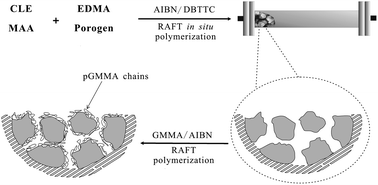A novel imprinted monolithic material with the ability of protein exclusion was developed for the selective extraction of clenbuterol (CLE) from biological samples by direct injection in the HPLC analysis. The material has an imprinted inner structure and hydrophilic outer layer. The reversible addition–fragmentation chain transfer (RAFT) polymerization was employed in the material preparation by a two-step procedure. In the first step, clenbuterol imprinted monolithic polymer was synthesized by combining the molecular imprinting and the RAFT polymerization techniques. The resulting monolithic polymer has a RAFT chain transfer agent (trithioester groups) in its structure, which was used to graft poly(glycerol mono-methacrylate) [pGMMA] in the second step by post-RAFT polymerization. The hydrophilic pGMMA layers grafted on the surface of the imprinted monolith created barriers for protein diffusion. More than 90% of bovine serum albumin can be excluded from the pGMMA coated monolithic column. Meanwhile the clenbuterol was retained selectively with a large retention factor. The result indicated that the column, denoted as RA-MIM, has both the merits of a molecularly imprinted polymer and restricted access material. By using RA-MIM as the solid-phase extraction pre-column, an on-line column-switching HPLC method for the determination of clenbuterol in human serum has been established and validated. The recoveries of clenbuterol from the serum were 87.3–96.9% in the spiked level 2–1000 ng mL−1. Both good linearity (R = 0.999) and acceptable reproducibility (RSD < 7.0%) were obtained. The limit of detection and the limit of quantitation were 0.7 ng mL−1 and 2.0 ng mL−1 respectively, which is sensitive in terms of UV detection. The results have demonstrated that the RAFT polymerization can be used to synthesize bi-functional monolithic columns by using its living reaction property. The resulting RA-MIM in this research can be used for efficient clenbuterol determination by HPLC from biological samples.

You have access to this article
 Please wait while we load your content...
Something went wrong. Try again?
Please wait while we load your content...
Something went wrong. Try again?


 Please wait while we load your content...
Please wait while we load your content...